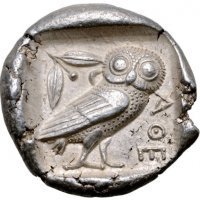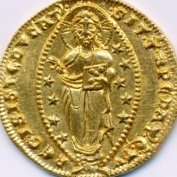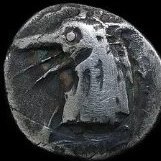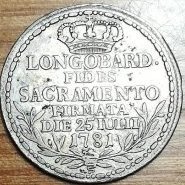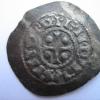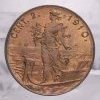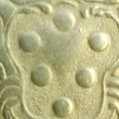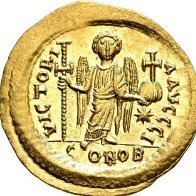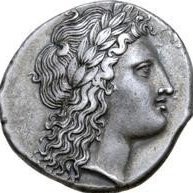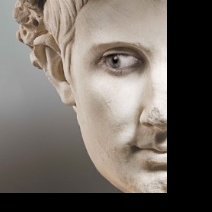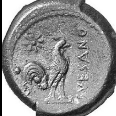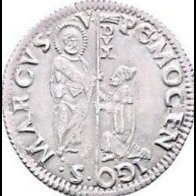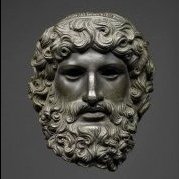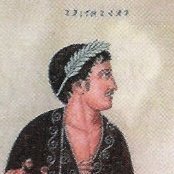Classifica
Contenuti più popolari
Elenco dei contenuti che hanno ricevuto i maggiori apprezzamenti il 12/14/23 in tutte le aree
-
Freccia del nord! Marione! Ora mi permetto di far io una recensione sul prodotto numismatico che da anni hai fatto crescere con una grande spalla come Marco @El Chupacabra Il nuovo gazzettino,è più spesso,quindi questo è sinonimo di più partecipazione,più entusiasmo,più divulgazione del verbo numismatico. In primis,complimenti per questo . Da non sottovalutare ovviamente il fardello che ti auto imponi per questa mostruosa creatura e che fai in modo che esista. Inoltre vorrei fare un plauso anche alla mano tecnico esecutiva di @El Chupacabra ,che ha curato l' ennesima volta egregiamente gli aspetti dell' impaginazione ecc.. Tra l' altro mi piace molto la copertina,che con quel tramonto e quel tipo di carta dà un" impressione da biblioteca molto fine,calda ed elegante,pertinente a questa nostra passione😁. L' uso stesso dei colori mi piace molto,il rosso,marrone e verde in primis usato per le scritte e decorazioni. Le briciole.....che dire? Preziosi spunti schematici e chiari,preziosi. Grazie molte ragazzi,per me è un piacere ed un onore entrare in queste pagine profumate😁 Ps : l' odore della carta del gazzettino mi fa impazzire🤣4 punti
-
Buongiorno...oggi condivido un 6 tornesi per la Repubblica Napoletana, quello più comune ma sempre ostico in buona conservazione. Con questo ho migliorato la conservazione del pezzo che già possedevo. Resto ancora alla ricerca della variante ZN Ecco le foto:4 punti
-
Questo è l'ultimo falso acquisito per la mia raccolta... Ferdinando IV di Borbone,carlino 1798, diametro 18,84 millimetri,peso 1,15 grammi...3 punti
-
Gentilissimi amici proseguendo nella non facile (e decisamente costosa 😳) impresa di sostituire progressivamente i miei scudi sabaudi con esemplari di qualità, stasera sono lieto di presentarvi un millesimo in generale di media rarità, ma che diventa davvero difficile da reperire in elevata conservazione. La combinazione straordinaria di lustro, rilievi pressoché intatti e patina omogenea leggermente iridescente qui fanno la differenza abissale con i gradi inferiori di conservazione, che diventano molto più rintracciabili. Proviene dall’asta Nomisma Aste numero 5, lotto 1131 TOP POP, miglior esemplare certificato NGC, in slab n. 6141774-008. - MS 63. Certamente non regalata, ma in questa conservazione è moneta incredibilmente appagante, sia per gli occhi che per l’orgoglio di possedere un esemplare di tale qualità. Qualche lieve imperfezione al bordo inevitabilmente le impedisce di salire a MS64. Buona serata a tutti2 punti
-
Un esemplare "exceptional in hand" di tetradrammo da Reggio con al diritto testa frontale di leone ed al rovescio testa laureata di Apollo . Sarà l'8 Gennaio in vendita Heritage 3113 al n. 31001 .2 punti
-
Condivido totalmente. Fabio2 punti
-
Dai su,annusa pure tu quella carta e vedrai dirai la stessa cosa😁 Ma lo sai che la prima cosa che faccio prima di sfogliare un libro o una rivista è sentirne proprio il profumo della carta? Chi ama i libri qui???? Mhhhh non posso che pensare a @4mori ad esempio. Sicuramente lui mi capirà🤣 Ops aggiungo il buon @talpa 😁2 punti
-
Numismatico-feticista? È l'alba di una nuova specie...2 punti
-
Un falso d'epoca di una mezza piastra del 1839,peso 13,18 grammi...2 punti
-
In compenso ha un mercato vastissimo... la puoi spendere ovunque petronius2 punti
-
Anche il prof. Scacchi collezionava falsi d'epoca; lo testimonia la sua collezione ora custodita dalla Società Napoletana di Storia Patria.2 punti
-
Iscritta alla FSFI Federazione fra le Società Filateliche Italiane Email: [email protected] Telefono: (+39) 3498125912 (Attilio Maglio) Pagina Facebook Associazione Circolo Tempo Libero Siamo presenti sui maggiori social media marketing Weekend di venerdì 22 e sabato 23 marzo 2024 dedicato ad oggetti senza tempo. Torna il Memorial Correale, manifestazione di collezionismo giunta alla 61° edizione, si terrà all’interno dell'elegante e luminosa sala dell'Hotel Il Gambero, struttura alberghiera nei pressi degli scavi archeologici di Stabia, a circa 10 minuti a piedi dall'uscita di via Nocera della Circumvesuviana Napoli-Sorrento. In occasione dei 30 anni della fondazione del Circolo Filatelico Numismatico "Tempo Libero", saranno evidenziate tutte le iniziative per celebrare l’importante ricorrenza. Gli orari di apertura e chiusura saranno per entrambi i giorni dalle ore 9 alle 19. Per offrire massima accoglienza e convivialità ai presenti, sarà messo a disposizione un servizio bar e una sala ristorante, dove si potranno gustare prodotti tipici locali, pranzo completo a soli € 20. L’ingresso è libero e gratuito, all'interno della struttura ampio parcheggio custodito e videosorvegliato. In esposizione: Monete antiche e moderne, francobolli, banconote italiane ed estere, decorazioni militari, cartoline, storia postale, gettoni, tokens, stampe, orologi, folder, bollettini illustrativi, interi postali, album, immagini sacre, carte telefoniche, quotidiani, locandine, libri, fumetti, figurine, calendari militari, penne da scrittura, pins, spille, oggettistica varia, accessori e raccoglitori per collezioni. Come raggiungerci Cliccare sul logo Hotel Il Gambero per le indicazioni stradali dall'uscita del Casello autostradale di Castellammare di Stabia a strada Provinciale Varano n.135. L'Hotel Il Gambero è dotato di un parcheggio privato, di un ristorante e di un giardino, si trova a Castellammare di Stabia nella strada Provinciale Varano n.135. Si può raggiungere facilmente sia in auto, con l'autobus o anche a piedi, a 5 minuti dagli Scavi archeologici di Stabia, con l'opportunità imperdibile di visitare le stupende Villa Arianna e Villa San Marco, le antiche domus di Stabiae. Per ulteriori informazioni: Hotel Il Gambero Strada Provinciale Varano, 135, Castellammare di Stabia, Provincia di Napoli Sito: www.hotelilgambero.com Telefono: (+39) 081 8714488 Cliccare sul logo Eav Vesuviane per le indicazioni stradali a piedi, dall'uscita della stazione di via Nocera della linea Circumvesuviana Napoli-Sorrento a strada Provinciale Varano n.135. Cliccare sul logo Eav Castellammare Linea 2 per tutti i dettagli per raggiungerci tramite autobus.1 punto
-
1 punto
-
Quello con il leone dovrebbe essere, se ben ricordo, Chersonneso Taurico. Quello con il toro Bisanzio. Arka Diligite iustitiam1 punto
-
Si si, lo so benissimo. Era un modo per dire che secondo me il grado di conservazione oscilla tra Spl e mSpl. Siamo lì… Diciamo che siamo più vicini alla seconda.1 punto
-
A me sembra una commemorativa di Costantino con al rovescio Costantino in quadriga. Arka Diligite iustitiam1 punto
-
Capisco benissimo... tutti i bibliofili sono un po' biblio-feticisti, e l'odore così come il contatto con la carta, nuova ma anche e soprattutto antica, è attizzante 😁🤓1 punto
-
DE GREGE EPICURI Personalmente, non ho mai avuto tetradrammi con lo stesso conio di diritto, e rovesci di tipo diverso; ma evidentemente questo poteva succedere. Quanto alle differenze indicate fra i due diritti, direi che alcune sono più nette, altre molto meno. Si possono spiegare, in parte, con l'usura progressiva cui andava incontro il conio stesso, specie se usato così abbondantemente; ma anche con le differenze fra un colpo di martello e l'altro, dato che le martellate potevano essere assestate in modo asimmetrico (un po' più a destra, o un po' più a sinistra...)1 punto
-
The Avars (And Their Belts) by S. Caza (Otlichnik) The Pannonian Avars (as distinct from the modern Avars of the northern Caucasus), sometimes called Pseudo-Avars by the Byzantines, were an alliance of Eurasian nomadic groups from the Asian steppes. In this way they were similar to the Huns of the 4th– 5thcenturies By the time they inhabited the Pannonian basin, the Avar confederation was primarily Turkic but likely also included, Mongol, Tungut, Uralic, Germanic and Slavic tribes or elements. The contemporary Bulgars were an alliance with the same general ethnic mix, but located to the east, and then southeast, of the Avars. In 567/568, the Avars, with the help of the Lombards, defeated the Gepids and took over the Pannonian basin. The Lombards moved into northern Italy (Lombardy) and the Avars established the First, or Early, Avar Khaganate. From 582 to 584 the Avars captured Sirmium, Singidunum (Belgrade), and Viminacium. At first relatively large, this Khaganate shrank until it encompassed little more than the Pannonian plain by the early 7thcentury. In the Middle Avar Period, in the late 7thcentury, the Avars allied with the Balkan Slavs to defeat the Bulgars and retain their independence. During the Late Avar Period, in the 8thcentury, new steppe tribes, including Turkic Onogurs, Iranian Alans and Mongolian peoples, joined the Avar Khaganate, likely introducing the new griffon and tendril decorative styles. The Avar Khaganate was conquered by Charlemagne’s Franks, allied with the Slavs, in the 890s. The Avar’s “ring”, or "hring", their fortified capital encampment, was sacked and the Avars were converted to Christianity. The Khaganate fell apart, with the Avar population falling under the Frankish and Bulgar states. Avar identity generally faded, though some pockets remained in the Great Hungarian Plain until the arrival of the Magyars in the late 9thcentury, and in eastern Austria (Burgenland) under the Franks. Avar Periods Avar history is generally divided into the Early, Middle and Late periods. However, there are several variations of the dating among historians. Below are two. Diam Early Avar: 568 – 650/670 Middle Avar: 650/670 – 700 Late Avar: 700 – 800/820 Stadler Early Avar I: 568 – 600 Early Avar II: 600 – 630 Middle Avar I: 630 – 655 Middle Avar II: 655 – 680 Late Avar I: 680 – 720 Late Avar II: 720 – 760 Late Avar III: 760 – 822 Avar Belt Sets Most Avar-related items today are from belt sets, which were an important component of Avar identity. Interestingly, based on the excavations of several thousand undisturbed Avar graves, only approximately 10% of male Avar graves contained belt sets. This likely indicates that they were restricted to a warrior and/or village leader class. (Szenthe, 2019, p.296.) Avar belt sets consist of a confusing array of parts. They can be divided, and dated, based on decorative styles. Breuer (2005) has classified them based on shape and design. Buckles Avar buckles were sometimes plain, but usually had an integral decorated plate. Avar belt buckle (Breuer type 4A) with integral plate (with Lily or Tree-of-life decoration). Buckle plate, Geometric Circular Lobe style, Late Avar III period. Belt Plates There are three main types of Avar decorative belt plates. Tiny decorative plates were used on various part of the belt, including along the narrow main body of the belt, above the hanger-plates on the thicker part of the belt (on the wearer’s backside), and/or on the many short leather straps that hung down from the belt. These tiny plates were usually triangular, pointed, or half-round, usually with a floral design. They had small holes for attachment, and maybe a big hole for decoration, and had a plain flat back. They were likely attached with tiny rivets, though some may have been sewn on. Two tiny Avar belt plates (Breuer type 2A) with vegetal style decoration. The left has three small rivet holes, the right has two (top and bottom). Medium-sized decorative plates were used on the narrow main part of the belt. They were attached to the belt with rivets. A medium-sized belt plate. This plate is one-sided and was fastened to the belt with two rivets but has no hinge for a hanger. Medium-sized hanger plates were similar to decorative plates, but had a hinge on the bottom from which a small pendant hung. Hanger plates with pendants were used on the wide part of the belt. The tiny pendant is often confusingly similar to the tiny decorative plates, but has a hinge at the top. These tiny pendants either hung below the belt, or on the side of the belt and likely jangled. Three different Avar belt hanger-plates with pendants (with different decoration styles) and one separate pendant. Strap Ends There are two types of Avar strap ends. Though strap ends often looked very similar to belt plates they were usually two-sided and were attached in a different manner. Instead of being riveted to the belt they were hung from the end of a strap. They therefore had a recess for the strap at their top. Confusingly, many Avar strap-ends were made in two parts. The two sides of the strap end were fitted over the leather strap and attached together with small rivets. This was likely a more secure means of attachment to the strap than the one-part strap ends, which only accommodated a short length of strap. Medium-sized strap ends were used on the bottom of the many short leather straps that hung down from the belt. Three medium-sized strap ends (with Lily style decoration). They are two-sided and have each have two rivets, in small lobes at the, to affix the strap end to the strap. One large strap end was used on the end of the belt itself. These rarely survive whole today. Broken upper-half of a large Avar strap end (with S-tendril style decoration). This one-sided plate was riveted to an identical back plate, with the leather strap sandwiched between. Belt Set Styles The type of decoration (animal, floral, vegetal, etc.) used on belt sets varied over time as did the shape of the belt plates. There are many different, often conflicting, typologies of Avar belt set styles. I have gone with the most recent, Szenthe (2013) for the Late Avar period. Surprisingly, Avar belt sets did not consist of belt fittings with only one design. Instead, several different styles of belt fitting could be found in any given belt set. This only ended in the late Avar IIIa period when sets consisting of only the Floral Geometric Horizon or Geometric Circular Lobe style were common. (Szenthe (2019), p. 301.) Early Avar (EA) Period Styles [circa 568 – 650/670] Early Avar belt sets contained either Byzantine styles, such as the “Mask” or the Martynovka styles, or plain fittings (in silver or iron). Only buckles were cast, other parts were made of stamped or sheet metal. Byzantine Mask Style • Circa 575 – 600. • A Byzantine, not Avar style. Obsolete by Early Avar era, but still occasionally found in Avar graves. • Simple plates with round and other shaped holes. Some looked like a mask. • Rarely appeared as full sets, just pieces here and there. Possibly trophies. (Daim, 2003, p.478.) Byzantine "Mask" style belt plate. Used during Early Avar Period. Byzantine "Mask" style strap-end. Used during Early Avar Period. Martynovka Style: • Circa late 6thand early 7thcentury. • Plain metal, with stylized linear and scroll style incised decoration • Aka Tamga style. Middle Avar (MA) Period Styles [circa 650/670 – 710] Strap ends had waisted edges and a pointed end. Most fittings, other than buckles, were sheet metal or stamped. Other cast fittings appear at the very end of MA Period. Stolbica I Style: • Circa late 7th and early 8thcentury. • X-lattice, often openwork. Short strap-end with X-form lattice openwork, from Middle Avar II Period. Griffon & Tendril Style • Circa late 7th and early 8thcentury. • Rectangular belt plates with griffons. Late Avar (LA) Period Styles [circa 710 – 820s] Belt sets are far more common. Many fittings are cast. Strap ends can be either 2-sided or 1-sided. Late Avar I and Late Avar II [circa early to mid 8thcentury] Late Avar I Belt plates are rectangular and oval. Strap ends have slightly waisted edges and pointed end, but usually less pronounced than in the Middle Avar period. Avar strap end with "Wavy" or "Tooth" design. Unknown style type. Note waisted sides, pointed end and flat reverse. Late Avar II Belt plates are shield, pentagonal and round shaped. Strap ends have parallel edges and a rounded end. Late Avar Animal Style • Used in both LAI and LAII periods. Circa 700 – 760 • Also called Griffon & Tendril style. • Rectangular hanger plates, with griffons continue from MA period. • Almost-square decorative plates with griffons. • With vegetal S-tendrils and circular lobes, but the small leaves / lobes are round with dimples. (Unlike later pointed or leaf-shaped lobes.) • Strap ends have a slight waist, slightly pointed bottom, and flat top. • All fitting types are often in openwork design. Half of a symmetrical silver-plated belt plate with animal design. Likely Late Avar I period. Shield-shaped hanger plate in Late Avar Animal style - tendrils only. Strap-end in Late Avar Animal style, griffon on one side with tendrils one the other. The slightly waisted sides and rounded end mean this is a late example of this style. Strap-end in Late Avar Animal style, though with tendrils only. Note the waisted sides, pointed end and round dimpled lobes (see right hand image). Two strap-ends in Late Avar Animal style, though with tendrils only. Note the waisted sides, pointed ends and round dimpled central lobes. Short strap-end in Late Avar Animal style, though with tendrils only. The sides are now parallel though the end is still slightly pointed. The central lobes are small domed circles. Heart Style • This is actually a sub-style of the Late Avar Animal Style. • Aka Mikulcice style. • Circa 730 – 760. • Uses a heart-shaped floral palmette vegetal design instead of the tendril and lobe with round lobes design. Broken upper half of large Avar strap-end in Heart style. Late Avar II period. Late Avar Horizon Style • Circa 730/740 – 760 • Almost-square griffon plates, but not hangers, still in use. • Also uses tendril and lobe vegetal designs, usually more intense with more petals than for the Animal style. • Oval or shield-shaped hanger plates. • Strap ends have parallel sides, round bottom, and flat top. • Many fittings are often in openwork design, usually with lots of small holes. Late Avar III [circa late 8th to early 9th century] Belt plates are strap-end shaped (oblong with one flat or squared-off end). Earlier belt hanger plates are wider at the top (rounded end). Later they have parallel edges. Strap ends have parallel edges and a rounded end. Sets have the most fittings, up to 30/belt. Strap ends often have animal heads at top. Made of bell bronze, with more lead than earlier normal tin bronze. Geometric Circular Lobe Style • Circa mid to late 8thcentury, likely used into 9thcentury. • Also called Geometric Scrollwork style, Floral-Geometric Horizon style or Aleppo style. • With vegetal S-tendrils and circular lobes, but the small leaves / lobes are more natural, leaf-shaped, pointed or hook-shaped with dimples. (Unlike earlier round and dimpled lobes.) • Strap-end shaped hangers. Belt plates and hangers have slightly pointed bottoms at first, then rounded bottoms. • Strap ends have parallel sides, round bottom, and twin pointed or rounded “ears” or lobes on top, each for one rivet. • Most fittings are solid plates with stamped or etched design. Little if any openwork. Belt buckle plaque in Geometrical Circular Lobe style. Belt buckle plaque in Geometrical Circular Lobe style. Belt plate (not hanger) in Geometric Circular Lobe style. Two Avar hanger plates in Geometrical Circular Lobe style. Four more hanger plates in Geometrical Circular Lobe style showing the wide variety of tendril forms. Half of a two-piece strap-end in Geometrical Circular Lobe style. This is probably an early version as it has a flat top with no "ears" or lobes. Two part medium-sized strap-end in Geometrical Circular Lobe style, held together with three rivets. Two-part medium-sized strap-end in Geometrical Circular Lobe style, held together with two rivets. One half of a two-part medium-sized strap-end in Geometrical Circular Lobe style. Two separate halves of medium-sized strap-ends in Geometrical Circular Lobe style. Two separate halves of medium-sized strap-ends in Geometrical Circular Lobe style. These fine examples have openwork, which is scarce for this type. Upper half of one side of a large two-part strap-end. Decorated in Geometrical Circular Lobe style. Final Avar Phase Style • Last Avar style introduced. [Csaba] • Circa late 8thto early 9thcentury. • Axially-symmetric small-sized vegetal designs, known as Lily, or Tree-of-life. • Initially with clear vegetal decoration, but later examples have a “degenerate” style consisting mostly of unadorned rims and holes. • Strap ends have parallel sides, round bottom, and twin animal-head “ears” or lobes on top. • Most fittings are openwork design. Two early, wider-top, hanger plates, in Final Avar Phase (aka Lily or Tree-of-life) style. Two hanger plates, one with small square pendant, in Final Avar Phase (aka Lily or Tree-of-life) style. Two more hanger plates, one with small triangular pendant, in Final Avar Phase (aka Lily or Tree-of-life) style. Hanger plate with loop for pendant, instead of hinge, in Final Avar Phase (aka Lily or Tree-of-life) style. Two tiny belt plates (Breuer type 2A), in Final Avar Phase (aka Lily or Tree-of-life) style. Three strap-ends in early (finer) Final Avar Phase (aka Lily or Tree-of-life) style. Two strap-ends in middle (beginning to degenerate) Final Avar Phase (aka Lily or Tree-of-life) style. Strap-end in Final Avar Phase (aka Lily or Tree-of-life) style. This example has no openwork, unlike most examples of this style. The reverse is also flat. This was a one-piece strap-end. The strap attached to the top where a tiny flat plate (missing) was attached with two-rivets. This style of attachment had generally dies out in the LAI period. Strap-end with unique bar method of attachment, in Final Avar Phase (aka Lily or Tree-of-life) style. Thick with Beaded Rim • A sub-style of the Final Avar Phase style. • Strap ends are very fat or thick and have beaded borders. Most are one-piece, but two-piece examples exist. • Solid cast bronze but made in imitation of intricate hollow multi-piece Byzantine goldwork. Two one-piece thick strap ends with beaded rims, from Late Avar III Period. One half of a two-piece thick strap-end with beaded rim, from Late Avar III period. Incised Vine-leaf Style • A sub-style of the Final Avar Phase style. • Also called stabchenranke (“stick-vine”) style. Often used with Scaled Frame strap-ends (below). • Small solid (i.e. no openwork) strap-end shaped hanger plates with floral design incised or punched on surface. Three belt hanger plates, on with pendant, in Incised Vine-leaf Style, from Late Avar IIIb Period. Scaled Frame Style • A sub-style of the Final Avar Phase style. • Asymmetrical Hollow-“D” shape. • Open frame with scale design on rim. • Only attested in eastern Austria. Often used with Incised Vine-leaf style hanger plates (above). Pair of Scaled Frame strap-ends from Late Avar IIIb period. Other Avar Items (e.g. not belts) Finger ring reportedly found with Avar belt set fittings. It is bronze with simple incised line decoration. Avar woman's bracelet. Iron Avar arrowhead. While the most common Avar arrow type appears to be tanged iron tri-lobate, very similar to late Roman and Hunnic arrows, they also used leaf-form diamond cross-section tanged arrows. Avar iron lamellar armour. Eight broken lamellar plates, fastened together with modern wire. Not typical concave curve in left edge of leftmost two pieces. Bibliography Breuer, Eric. Byzanz on der Donau, 2005. Csaba, Szalontai. A keso avar kori liliomos ovveretek. Daim, Falko. “Byzantanische” Gurtelgarnituren des 8. Jahrhunderts, in Die Awaren am Rand der byzantinischen Welt, 2000. Daim, Falko. Avars and Avar Archaeology: An Introduction, in Regna and Gentes: The Relationship between Late Antique and Early Medieval Peoples and Kingdoms in the Transformation of the Roman World, 2003. Diam, Falko. Byzantine Belt Ornaments of the 7th and 8th Centuries in Avar Contexts, in Intelligible Beauty: Recent Research on Byzantine Jewellery, 2010. Gabor, Kiss. A kesoi avar aranyozott ovdiszek. Rustoiu, Aurel. Shooting the evil. “Scythian” arrowheads in Avar age graves from the Carpathian Basin, in Calin Cosma ed. Warriors, weapons, and harness from the 5th–10thcenturies in the Carpathian Basin, 2015. Stadler, Peter. Ausgewahlte Awarische bronzegusse als parallelen zu Gurtelbeschlagen von Vrap und Erseke, in Der Schatzfund von Vrap in Albanien, 1986. Szenthe, Gergely. Vegetal ornaments in the Late Avar decorative art, in Dissertationes Archaeologicae ex Instituto Archaeologico Universitatis de Rolando Eötvös nominatae Ser. 3. No. 1, 2013. Szenthe, Gergely. Material culture patterning as the source of the Avar power network, 8thcentury AD, in Dissertationes Archaeologicae: ex Instituto Archaeologico Universitatis de Rolando Eötvös nominatae Supplementum 2, 2018. Szenthe, Gergely. The Late Avar Reform and the Long Eigth Century, in Acta Archaeologica Academiae Scientiarum Hungaricae 70, 2019. https://www.forumancientcoins.com/numiswiki/view.asp?key=avar1 punto
-
Segnalo anche il sito numista. Copre un arco cronologico e una ampiezza geografica davvero enormi con una, tutto sommato, ottima accuratezza per essere una risorsa online. https://en.numista.com/catalogue/index.php?ct=coin1 punto
-
In Canada l'hanno definita una "scultura", se la zecca italiana avesse fatto un qualcosa di simile con le nostre vecchie lire ad un prezzo ragionevole anzichè quell'inutile serie "storia della lira" molto probabilmente l'avrei presa, anche se penso che un chilo d'argento l'avrebbero fatto pagare come se fosse un chilo di palladio!1 punto
-
No, continuo a non essere d'accordo. L'osella era moneta e poteva essere spesa. Questa medaglia no. Quindi non è un'osella. Arka Diligite iustitiam1 punto
-
Prima del '700 ci sono quasi due millenni di coniazioni, dovresti essere più preciso.1 punto
-
Non è proprio così. La vendita ha delle conseguenze legali e fiscali. E ci sono i diritti degli altri competitori all'asta. Arka Diligite iustitiam1 punto
-
Buonasera a tutti, Vediamo se apprezzate di più i grossi moduli ? Re Umberto I per me ha sempre avuto un fascino particolare, e ho sempre desiderato comporre una serie, anche solo tipologia, di un certo livello. Da un po’ ho avuto modo di inserire in collezione questo esemplare grazie ad un noto commerciante. È logicamente il tassello più pregiato ed importante dei moduli in argento. Cosa ne pensate? ?1 punto
-
Del tallero 1654 un mio amico ha avuto la fortuna in Firenze da un privato di poterla vedere, credo Ve ne sia 1 solo esemplare.1 punto
-
Buongiorno e Grazie amico!! Concordo in pieno sul discorso della difficoltà nel reperire il 2 stelle in conservazione buona...ne ho lasciati passare 2/3 per poi trovare questo, che nonostante alcuni difetti mi appaga! Complimenti anche per la tua collezione, che ormai è ben avanzata!!! Un caro saluto. Cristiano.1 punto
-
ecco, qui ti sbagli: sottovaluti la stupidità umana. Da te non me lo aspettavo! 🤣 https://www.thestar.com/news/mysterious-spy-coin-simply-poppycock/article_e9b0a60e-1c60-57ae-923f-ca211f162fca.html https://www.cbc.ca/news/science/poppy-quarter-led-to-spy-coin-warnings-1.649741 The mystery behind Canada's "spy coins" is solved. The Defense Security Service: adesso ne sto già osservando una sulla baia, magari la prendo e la metto di nascosto nella borsetta di mia figlia Servus, Njk1 punto
-
Penso che la slab e‘ il male numismatico. L‘unico vantaggio della slab e‘ che puoi aprire la scatoletta e disfarti della plastica.1 punto
-
Io da qualche anno vivo in Svizzera italiana, che è piccolissima, ma che sebbene si possa pensare diversamente, al netto di qualche sfumatura che non fa la differenza, ha tutte le problematiche dell’Italia. Lo stesso posso dire dI Olanda, Germania, Austria e Svizzera interna.1 punto
-
1 punto
-
È la prima volta che vedo l’aggettivo tempestuous (tempestoso, turbolento) attribuito alla patina di una moneta. Se poi aggiungiamo il leone con doppio collare da una parte e un toro dall'altra, c'è poco da star tranquilli! apollonia1 punto
-
Forse non tutti sanno che…prima di diventare un insigne numismatico specializzato in banconote…un grande!! Guido Celestino Egidio Crapanzano (nato a Brescia, 6 marzo 1938) aveva lasciato gli studi per seguire l'inclinazione artistica. Debuttò come cantante nel 1957, vincendo un concorso per dilettanti al Teatro Alcione di Milano. Debuttò discograficamente con la Durium, con il 45 giri "Ciao ti dirò"/"Ma l'amore no". Nel 1962 entrò nel Clan Celentano, poi partecipò al primo Cantagiro. Nel 1963 fondò l'orchestra Guidone e i suoi Amici (nota anche come Guidone e la sua Ghenga) di cui facevano parte Enrico Maria Papes, Checco Marsella e Mino Di Martino che poi fonderanno I Giganti.1 punto
-
con T è stato-rischierà T? - I CONTESTATORI SCHIERATI Buona notte Stilicho1 punto
-
Buonasera, escluderei Malta perchè al dritto è impressa l'aquila e non lo stemma del gran maestro dell'ordine di Malta. Si può pensare che la moneta è simile a quella di un grano di Filippo II con le iniziali di Pietro del Pozzo "P P" sotto gli artigli. Al verso, la scritta VT COMMO DIVS stona, la C è troppo aperta e la porosità sulla moneta mi farebbe propendere verso un falso d'epoca.1 punto
-
Più che doverosa, a maggior ragione visto che abbiamo preso una topica in due ☺️1 punto
-
Io invece qualcuno lo conosco. Pochi, ma ci sono. Sarà perché purtroppo ho moooolti più anni di te. 😉Certamente, a mio modesto modo di vedere, quando il collezionismo diventa compulsivo se non proprio una malattia rischia di trasformarsi in una serie di comportamenti in realtà del tutto avulsi dalla propria sfera di discrezionalità. Si crede infatti di essersi comportati con libertà ma in verità non è così. E spesso quando si raggiunge il pezzo ambito a prezzo di enormi (e a volte sproporzionati) sacrifici, la soddisfazione dura magari mezza giornata subito sostituita dal desiderio spasmodico del pezzo successivo, in una sorta di farandola perniciosa. Fortunatamente, nella mia umile opinione, questo quadro decisamente fosco si rintraccia in pochi casi e si tratta di vere eccezioni che vanno compatite e, laddove possibili, aiutate.1 punto
-
Canada 2017 - 250 dollari in Ag.999 Moneta scultura ad alto rilievo da 1 Kg. d'argento. Presenti i principali ritratti sulle monete canadesi circolanti dall'apertura della Zecca Reale Canadese nel 1908, Le repliche di oltre 35 monete storiche, tutte riprodotte con gli stessi identici diametri degli originali. Il leggendario dollaro Voyageur, lanciato per la prima volta nel 1935 Tutti e sei i famosi disegni della fauna selvatica del Centenario canadese del 1967 Tutti e sei i modelli attualmente in circolazione in Canada (incluso il pezzo da 1 centesimo la cui produzione è terminata nel 2012) Il nickel Vittoria della Seconda Guerra Mondiale emesso dal 1943 al 1945 Il dollaro che celebra il diritto di voto delle donne La moneta da 25 centesimi del Canadian Poppy * Il dollaro del Giorno della Memoria 1994 La moneta da 25 centesimi della spedizione artica canadese Gli Eroi del 1812 da 25 centesimi Moneta da 2 dollari della Guerra del 1812 raffigurante la HMS Shannon Moneta da 25 centesimi della serie canadese Conservation Wood Bison Moneta da 25 centesimi della bandiera canadese del 2015 Le effigi di: Re Edoardo VII Re Giorgio V Re Giorgio VI La Regina Elisabetta II * Poppy quarter - La moneta papavero Il quarto di dollaro canadese del 2004 è la prima moneta colorata del mondo destinata alla circolazione. Passa alla storia per essere stata scambiata per una moneta spia. Funzionari della difesa americana videro la moneta papavero per la prima volta nel 2007. Dopo i primi esami avevano erroneamente concluso che il rivestimento protettivo è stato utilizzato per nascondere un dispositivo di sorveglianza a distanza. Pensarono che venivano messi in tasca agli statunitensi appartenenti all'esercito che viaggiavano in Canada per successivamente monitorarli. Non si sa bene come sia stato gestito l'imbarazzante episodio tra la security statunitense e quella canadase, in un rapporto finale gli americani ammettono che le monete destano sospetti, ma in ultima analisi non c'e' nulla di cui preoccuparsi. Non era nanotecnologia, era solo un rivestimento convenzionale di protezione pensato dalla Royal Canadian Mint ed applicato per evitare che il colore rosso del papavero andasse via per usura da sfregamento. Furono prodotti circa 30 milioni di questi quarti nel 2004 per commemorare 117.000 canadesi morti in guerra. I 25 centesimi presentano l'immagine di un papavero rosso intarsiato su una foglia d'acero, il rosso dovrebbe ricordare il sangue versato dei soldati caduti.1 punto
-
1 punto
-
Questa provinciale è rara. Ma è presente sia su acsearch che nel RPC (stessa moneta). Di fronte al personaggio con elmo ci sono due altri personaggi, uno è in piedi. Al dritto, un imperatore del II sec.1 punto
-
Il bronzo del quiz è stato battuto alla Obolos, by nomos WEBAUCTION 11 nel 2018, con un risultato notevole in termini di offerta essendo stato aggiudicato a un hammer di 6000 CHF da una base d’asta di 700 CHF. Lotto 427. TROAS. Ilium. Marcus Aurelius, 161-180. Medallion (Bronze, 35 mm, 27.97 g, 7 h), 161-165. AYT KAI M AYPHΛ ANTΩNEINOC Laureate, draped and cuirassed bust of Marcus Aurelius to right. Rev. ΕΚΤΩΡ / [IΛIEΩN] Andromache standing left presenting little Astyanax to Hector standing right in full armor . RPC 87 (temporary), citing only one example in the Hermitage Museum from the excavations of Schliemann (Bellinger T 150). Extremely rare, well struck with a brown patina and with a stunning reverse. Some rough areas, otherwise, good very fine. This stunning and totally dramatic scene is a breathtaking depiction of the last meeting of Hector with his wife Andromache, just before he faces the almighty Achilles in a fierce battle that will cost his life. Andromache with little Astyanax in her hands pleads Hector not abandon the safe walls of Troy for the sake of his son. The infant on the other hand is frightened by his father's crested helmet and started to cry. This is probably the most dramatic scene in Homer's Iliad (VI, 390-480). Anche qui si commenta la scena drammatica che rappresenta l’ultimo incontro di Ettore con la moglie Andromaca poco prima di affrontare Achille in una feroce battaglia che gli costerà la vita. Andromaca, con il piccolo Astianatte tra le mani, supplica Ettore di non abbandonare le sicure mura di Troia per amore del figlio. Il piccolo, invece, è spaventato dall'elmo crestato del padre e comincia a piangere. Questa è probabilmente la scena più drammatica dell'Iliade di Omero (VI, 390-480). apollonia1 punto
-
Buonasera a tutti, la mia Vicereale di oggi: 3 Cavalli Filippo III D/PHILIPP-III-D. G. REX.ARA. VT R/IN HOC SIGNO VINCES Magliocca 82 "La Moneta Napoletana Dei Re di Spagna Nel Periodo 1503 - 1680" Siete D'accordo? Saluti Alberto1 punto
-
Sfrega sfrega la lampada,magari il genio esce davvero eh.....🧞1 punto
-
@CdC ti pongo una domanda: non avrebbe più visualizzazioni questo "bronzetto" e magari qualcuno che potrebbe dire qualcosa in più se la spostassimo nella sezione delle identificazioni ? Chiedo questo perché adesso (vedendo un po' meglio dall'occhio destro) mi sembra di intravedere una sagoma femminile, e forse non si tratterebbe di un aes ma di una moneta molto danneggiata.1 punto
-
Buongiorno a tutti,un grano bislungo particolare,busto maturo al dritto e croce di Gerusalemme piccola al rovescio,ribattuto su tornese di Filippo Il...1 punto
-
Il pesos delle colonie spagnole deriva da quello coniato dalla zecca di lima intorno al 1565 pesava circa 27 g di argento per il 92% di argento puro...prima vi era il real de a ocho...il famoso pezzo da otto reales...e poi l'escudos d'oro il cui pezzo da 8 corrisponde al doblone...100000 pesos dovrebbero quindi essere circa 2,5 tonnellate d'argento puro...una cifra molto considerevole...se guardo il valore dell'argento puro ad oggi ottengo un milione e trecentomila euro...ma va calato sull'epoca dove l'argento non era cosi diffuso come oggi...dovresti vedere nel libro di Cipolla, vele e cannoni per comprendere se vi sono indicazioni del valore d'acquisto e rapportato ad oggi...azzarderei a dire alcune decine di milioni di euro di oggi, forse di più...il potere d'acquisto di una cifra del genere era quella di finanziare per qualche tempo una guerra spagnola in europa...all'epoca gli Asburgo si davano da fare... 😉1 punto
-
Il Ministero emette il 17 novembre 2023 un francobollo ordinario appartenente alla serie tematica il Senso civico, dedicato alla Giornata internazionale degli studenti, con indicazione tariffaria B zona 3. Tiratura: duecentocinquantamila venti esemplari Foglio: quarantacinque esemplari Caratteristiche del francobollo La vignetta raffigura alcuni studenti di spalle, abbracciati, che ammirano un murales su cui campeggiano le scritte “SCHOOL”, “DIRITTO ALLO STUDIO”, “PEACE”, “PACE” e “SCUOLA”. Completano il francobollo la legenda “GIORNATA INTERNAZIONALE DEGLI STUDENTI”, la scritta “ITALIA” e l'indicazione tariffaria “B zona 3”. Bozzettista: Claudia Giusto Il francobollo è stampato dall’Istituto Poligrafico e Zecca dello Stato S.p.A., in rotocalcografia su carta: bianca, patinata neutra, autoadesiva, non fluorescente; grammatura: 90 g/mq; supporto: carta bianca, Kraft monosiliconata da 80 g/mq; adesivo: tipo acrilico ad acqua, distribuito in quantità di 20 g/mq (secco); formato carta: 30 x 40 mm., formato stampa: 30 x 38 mm.; formato tracciatura: 37 x 46 mm.; dentellatura: 11 effettuata con fustellatura; colori: cinque.1 punto
-
Annuncio la imminente uscita di : La circolazione monetaria nel territorio di San Pietro Infine - Una guida introduttiva Davide Fabrizi, Beniamino Russo L’opera, nata nel corso delle commemorazioni per la battaglia avvenuta a San Pietro Infine durante la Seconda Guerra Mondiale, si pone l’obiettivo di illustrare ai giovani ed ai neofiti la storia della circolazione monetaria che ha riguardato il centro attraverso i secoli, dai Sanniti fino all’Unità d’Italia. Il libro ha quindi un carattere prettamente divulgativo, illustrando con immagini e brevi descrizioni, i tipi principali delle monete che sono circolate nelle aree limitrofe. pagine a colori, formato foglio 18x261 punto
-
1 punto
-
Strano che nessuno abbia chiesto questo particolare ? di solito la richiesta ci scappa sempre1 punto
Questa classifica è impostata su Roma/GMT+01:00
Lamoneta.it
La più grande comunità online di numismatica e monete. Studiosi, collezionisti e semplici appassionati si scambiano informazioni e consigli sul fantastico mondo della numismatica.
Il network
Hai bisogno di aiuto?
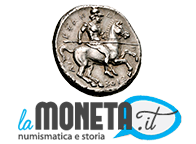


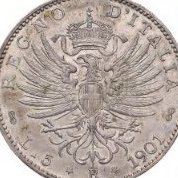

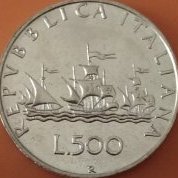


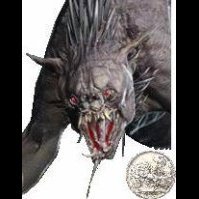

_compress55.thumb.jpg.3fa3bd76a5efe685e4de20ff9bd635b4.jpg)

